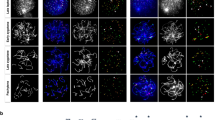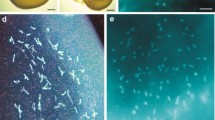Abstract
Chromosome pairing has been examined in foetal oocytes of mice heterozygous either for an X-linked inversion, In(X)1H, or an autosomal inversion, In(2)2H. The patterns of chromosome pairing have been screened systematically in foetuses of different gestational ages in a search for a “production-line” effect particularly affecting the inversion-bearing bivalents. The proportion of pachytene oocytes with a loop fell with increasing gestational age for both inversions. The decrease was linear for In(X)1H but best described by a quadratic function for In(2)2H. Examination of late zygotene cells and a comparison of loop frequency in early, mid and late pachytene oocytes suggested this age-related decrease to be principally due to synaptic adjustment and not to a production-line effect. However, two particular observations were somewhat at variance with this conclusion. Firstly, in In(X)1H heterozygotes, the presence of an inversion loop and the occurrence of partial pairing of long/long-medium bivalents at pachytene were independent of each other only on day 19. Secondly, although the proportion of oocytes with a loop fell overall, there was a rise at 19 days in In(2)2H heterozygotes. Thus in both inversions there is some evidence of a change in pairing behaviour affecting the inversion-bearing bivalents at the latest gestational age, as would be expected under the production-line hypothesis.
Similar content being viewed by others
References
Bond DJ, Chandley AC (1983) Aneuploidy. Oxford Monographs on Medical Genetics No. 11. Oxford University Press, Oxford
Dietrich AJJ, Mulder RJP (1983) A light and electron microscopic analysis of meiotic prophase in female mice. Chromosoma 88:377–385
Evans EP, Phillips RJS (1975) Inversion heterozygosity and the origin of XO daughters of Bpa/+ female mice. Nature 256:40–41
Evans EP, Phillips RJS (1978) A phenotypically marked inversion (In(2)2H). Mouse News Lett 58:44–45
Henderson SA, Edwards RG (1968) Chiasma frequency and maternal age in mammals. Nature 218:22–28
Moses MJ, Poorman PA (1981) Synaptonemal complex analysis of mouse chromosomal rearrangements. II. Synaptic adjustment in a tandem duplication. Chromosoma 81:519–535
Moses MJ, Poorman PA (1984) Synapsis, synaptic adjustment and DNA synthesis in mouse oocytes. In: Bennett MD, Gropp A, Wolf U (eds) Chromosomes Today, vol 8. George Allen and Unwin London, pp 90–103
Moses MJ, Dresser ME, Poorman PA (1984) Composition and role of the synaptonemal complex. Symp Soc Exp Biol 38:245–270
Moses MJ, Poorman PA, Roderick TH, Davisson MT (1982) Synaptonemal complex analysis of mouse chromosomal rearrangements. IV. Synapsis and synaptic adjustment in two paracentric inversions. Chromosoma 84:457–474
Speed RM (1982) Meiosis in the foetal mouse ovary. I. An analysis at the light microscope level using surface spreading. Chromosoma 85:427–437
Speed RM, Chandley AC (1983) Meiosis in the foetal mouse ovary. II. Oocyte development and age-related aneuploidy. Does a production line exist? Chromosoma 88:184–189
Author information
Authors and Affiliations
Rights and permissions
About this article
Cite this article
Tease, C., Fisher, G. Further examination of the production-line hypothesis in mouse foetal oocytes. Chromosoma 93, 447–452 (1986). https://doi.org/10.1007/BF00285827
Received:
Issue Date:
DOI: https://doi.org/10.1007/BF00285827




